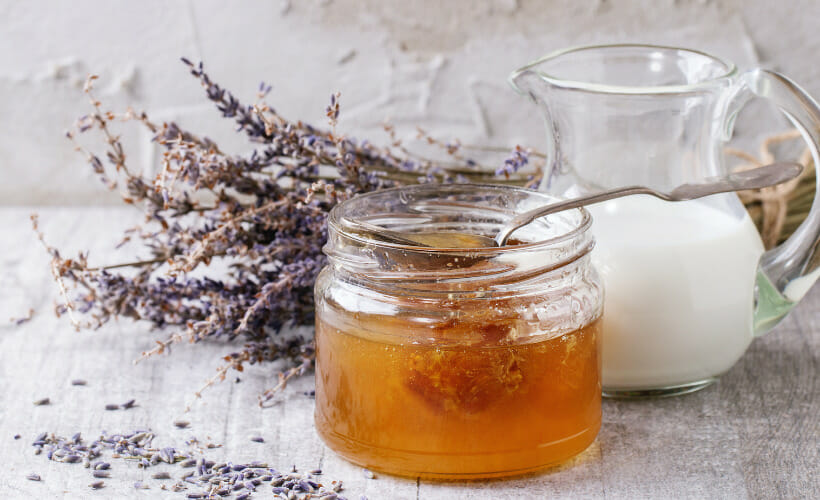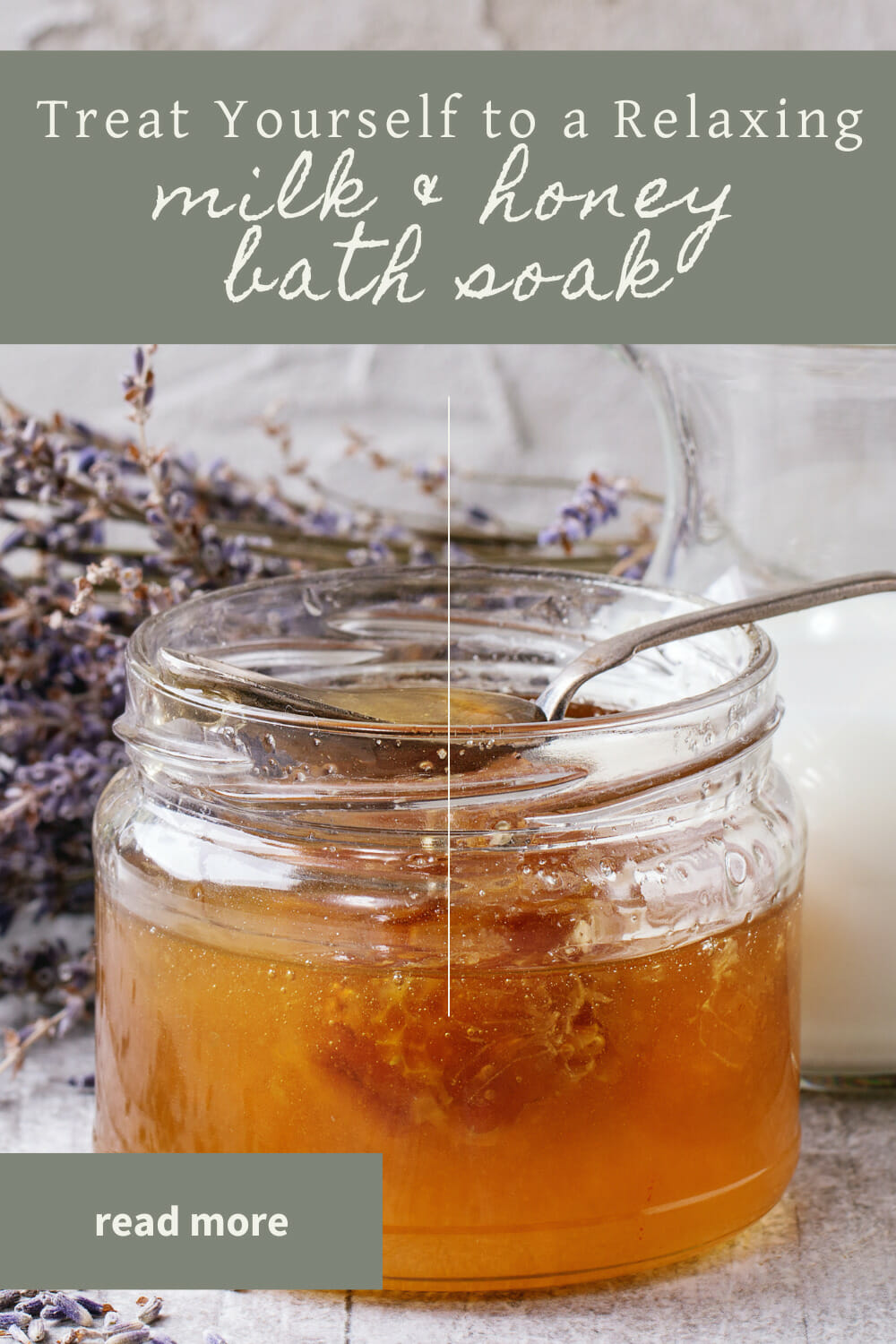Treat Yourself to a Relaxing Milk & Honey Bath Soak
Rejuvenate the mind, body, and soul with the incredible benefits of milk and honey in this luxurious and easy bath soak recipe.

Are you in need of a little TLC? Look no further than a milk and honey bath soak. Civilizations have cherished this indulgent at-home spa experience for centuries – and for good reason. With its natural skin-soothing and healing properties, milk and honey can work wonders for both your skin and soul. In this article, we’ll delve into the incredible benefits of milk and honey, from their individual powers to their synergistic effects when combined. Enhance your self-care routine with our easy milk and honey bath soak recipe – because you deserve a little pampering.
The Skin-Soothing Benefits of Milk
From Cleopatra’s legendary milk baths to modern-day skincare products, milk has long been used to nourish and rejuvenate the skin. Enriched with essential vitamins, minerals, and proteins, milk helps to hydrate and soften the skin, leaving the skin looking and feeling smooth and supple.
The lactic acid content in milk is one of the key reasons it benefits the skin. It acts as a gentle exfoliant, removing dead skin cells and promoting cell turnover, revealing a fresh, glowing complexion. It also helps to even out skin tone and texture, reducing the appearance of blemishes and discoloration.
Do you have dry skin?
Milk also acts as a moisturizer. It contains fats and proteins that create a protective barrier on the skin, locking in moisture and preventing dryness. This makes it particularly beneficial for individuals with dry or sensitive skin, as milk can alleviate itching and reduce inflammation.
Milk has anti-inflammatory properties that can soothe irritated and inflamed skin. It can provide relief for conditions such as eczema, psoriasis, and sunburn, helping to calm redness and reduce discomfort. The natural enzymes in milk also promote healing, aiding in the restoration of the skin’s health.
Do you have oily or combination skin?
In addition to its benefits for dry and sensitive skin, milk also offers advantages for those with oily and combination skin types. Despite concerns about potential excess oil, milk can still be incorporated into skincare routines for these individuals.
For oily skin, milk’s gentle exfoliating properties help to remove dead skin cells and unclog pores. This can reduce the occurrence of breakouts and ensure that excess oil doesn’t get trapped beneath the skin’s surface. Additionally, while milk moisturizes the skin, it does so without adding any additional oil, making it a suitable choice for oily skin types.
Combination skin can also benefit from milk’s dual nature. Milk’s exfoliating properties work to even out skin tone and texture, reducing blemishes and discoloration in areas with oilier skin. At the same time, its moisturizing capabilities help to hydrate and nourish any dry patches, promoting an overall balanced complexion.
By incorporating milk into a skincare routine, individuals with oily and combination skin can enjoy milk’s benefits without exacerbating any concerns related to excess oil or dryness. It remains an effective and versatile ingredient for a range of skin types, allowing for a comprehensive approach to self-care.
The Healing Properties of Honey
Honey has long been used and recognized for its potential skincare benefits. Some studies and research suggest that honey may have anti-inflammatory, antimicrobial, and wound-healing properties, which may contribute to its effectiveness in managing acne and soothing irritated skin.
When it comes to acne, honey’s antimicrobial properties may help combat acne-causing bacteria that contribute to breakouts. Its anti-inflammatory properties may also help calm redness and inflammation associated with acne.
Manuka honey has been studied as an anti-acne product and found to be significantly more effective than other popular products.
– AIMS Microbiol. 2018; 4(4): 655–664
For soothing irritated skin, honey’s natural anti-inflammatory properties may help reduce the discomfort and redness associated with various skin conditions such as eczema, psoriasis, and sunburn. It may also have moisturizing properties that help hydrate and nourish the skin, relieving dryness and itchiness.
The honey mixture appears useful in the management of dermatitis and psoriasis vulgaris.
– Complement Ther Med. 2003 Dec;11(4):226-34
Combining Milk & Honey for Double the Goodness
The healing properties of honey and the nourishing properties of milk go hand in hand, creating a luxurious and effective skincare treatment. Indulge in the ultimate self-care experience by incorporating a milk and honey bath soak into your beauty routine. These two natural ingredients work together to pamper your skin, leaving it looking and feeling its absolute best.
By combining milk and honey, you can harness the double goodness they offer. High in vitamins and minerals, milk acts as a gentle exfoliator, revealing a brighter complexion by removing dead skin cells. It also contains lactic acid, which helps hydrate and soften the skin, leaving it smooth and supple.
Honey is a powerhouse of antioxidants and antimicrobial properties. It helps to cleanse and clarify the skin, combating acne-causing bacteria and reducing inflammation. Honey also acts as a natural humectant, drawing moisture into the skin and providing deep hydration, resulting in a more youthful, dewy appearance.
Milk and honey create a potent combination that can transform your bathing experience into a spa-like retreat. As you immerse yourself in a milk and honey bath soak, the creamy texture of milk envelops your skin, nourishing it from within, while the soothing qualities of honey work their magic. This dynamic duo relaxes your mind and body while revitalizing your skin to leave it radiant.
Creating Your Own Milk and Honey Bath Soak
When it comes to milk and honey bath soaks, it’s important to consider potential allergies or sensitivities that some individuals may have. Here are some safety precautions and considerations to keep in mind:
Allergies to Milk
If you have a known allergy to milk or lactose intolerance, it’s best to avoid incorporating milk into your bath soak. Instead, consider using a plant-based alternative like almond, coconut, or oat milk.
Allergies to Honey
Individuals with bee allergies or a known allergy to honey should avoid using honey in their bath soak. Honey can cause an allergic reaction, so it’s better to err on caution.
Always prioritize your safety and well-being when trying new skincare treatments. If you experience any discomfort, redness, or irritation during or after using a milk and honey bath soak, discontinue use and consult a healthcare professional.
Gather Your Simple Ingredients
To create your own DIY milk and honey bath soak, you’ll need a few simple ingredients that you may already have in your pantry. Start by gathering high-quality milk and honey. If available, choose organic and raw honey for its higher nutrient content.
Next, find a tub or a large basin in which you can comfortably soak. Fill it with warm water, ideally at a temperature that suits your preference. Avoid hot water that can strip away your skin’s natural oils; use a warm and soothing temperature instead.
Now, it’s time to add the magic ingredients. Start by pouring about two cups of milk into your bathwater. You can use any milk you prefer – whether it’s whole milk for extra creaminess or a plant-based alternative for a vegan option.
After adding the milk, drizzle in a generous amount of honey. Start with around half a cup, but feel free to adjust the quantity based on your personal preference. Stir the mixture gently with your hand to ensure the milk and honey blend together.
Add Essential Oils for Aromatherapy
If you want to enhance the relaxation experience further, consider adding a few drops of your favorite essential oil. Lavender, chamomile, or rosemary are popular choices known for their calming properties and pleasant scents. Be sure to choose oils that are safe for skin application and properly dilute them before adding them to your bath soak. Sweet almond oil is a good carrier oil choice for diluting essential oils.
Add Epsom Salts to Relieve Aches
Epsom salts are a fantastic addition to a milk and honey bath soak. Not only do they enhance the relaxation factor, but they also offer various benefits for your skin and overall well-being. Epsom salts are known for their high magnesium and sulfate content. When dissolved in warm water, these minerals are absorbed through the skin and can help relax muscles, reduce tension, and promote a sense of calm and relaxation. They are perfect for easing sore muscles and relieving stress after a long day.
In addition to their relaxation properties, Epsom salts can also aid in detoxification. They help draw out toxins from the body and assist in the elimination of waste through the skin. This can contribute to a healthier complexion and improved skin tone. Add a few handfuls of salts to your warm bathwater to incorporate Epsom salts into your milk and honey bath soak.
Once the ingredients are well mixed, take a moment to breathe in the sweet and soothing aroma. Step into the bath and immerse yourself in the warm water. Allow the milk and honey to envelop your skin, bringing deep nourishment and hydration.
As you soak in your warm bath, take this time to unwind and let go of any stress or tension. Close your eyes and visualize the luxurious spa experience you’ve created for yourself. Feel the soothing qualities of milk and honey working their magic, revitalizing your skin and your entire being.

Maybe enjoy a facial while you soak? I have 6 Healthy Homemade Facial Masks for you to try out.
